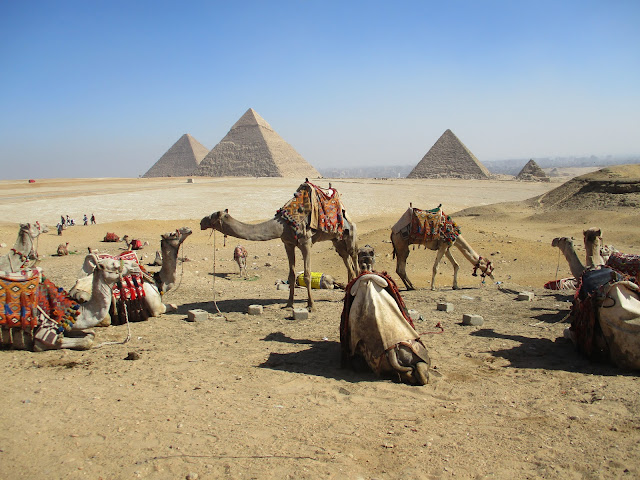Just a word about my traveling companions on this tour. We seem to be a pretty homogenous group. There are 16 of us. Three women and I make up the "singles" contingent. To be honest, two of the ladies are widows, and from what I can gather, their single status is not something they wanted or particularly embrace. Overall, we seem to be a pretty compatible troup of retired something or others who are traveling as an intended part of their retirement. So far, so good.
This was the second day of our excursion, although it is numbered as day 4. More pyramids, these of a much older vintage, a couple of museums, (where no pictures are allowed) and a nice lunch in an outdoor restaurant with musicians and cats (many cats!) in attendance.
Pyramid #1 was built in the third century B.C. by Pharaoh Snefer, and was intended to be a revolutionary development in the construct of tombs. Unfortunately, as the pyramid was being built, it was discovered that the pitch of the slope was too steep, and to continue would insure that near the top, the pyramid would collapse. The architect and engineers returned to the drawing board, and lower the angle by 10 degrees which allowed them to finish construction without mishap. Snefer, however, was not pleased, and insisted on building a new pyramid, using the information obtained from the first "failure." The result was the first true surviving pyramid of the type we would recognize today. The compromised one, I think, was abandoned and not used. The ancient drama has resulted in two iconic tourist sites, the Bent Pyramid, and the Red Pyramid, both seen below.
 |
The Bent Pyramid at Dahsur
The Red Pyramid (the keeper)
Our next stop was the necropolis of the Old Kingdom at Saqqara. This cemetery is said to hold the oldest monumental masonry structure in the world! If I learned my lessons correctly, I believe is belongs to Pharaoh Teti of the fourth century B.C. In close proximity to the burial mound (it can't really be called a pyramid!) is the tomb for his high priest Mereruka and his family. Although clearly a reconstruction, there were enough original bas reliefs, some with the color still visible, to present the essence of a "nobleman's" burial in the earliest centuries of the Egyptian kingdom. One unusual event occurred while we toured the priest's tomb. One of the "guards" approached our guide for a bribe, identifying himself a "corrupt", so that we could take pictures which was strictly against the rules. Our guide declined, and some of our crowd took pictures, anyway, thus proving that corruption breeds corruption, I suppose.
|
 |
Teti's mound at Saqqara (oldest monumental masonry structure)
Our next stop was the Imhotep Museum. Imhotep was an architect and engineer for many of the tombs we viewed, and a museum in his honor was opened to display a stunning array of the artifacts which have come to light through the more recent excavations in the area. The collection included many small statuettes of gods and mortals, larger sculpture and tools, alabaster jars and bowls and many fragments of reliefs which once adorned desecrated tombs in the area.
Our final pyramid before lunch was the Pyramid of Zoser, and the enormous ceremonial complex that surrounds it. The pyramid is more widely known, I think, as the Step Pyramid. Zoser was either the first of one of the first to rule over Upper and Lower Egypt, and made a great effort to demonstrate his power and control through elaborate ceremonies (annually) and massive building projects. His complex, for example, contains the first ever columns as supports, and the length of this wall separating the complex from the ordinary world was one mile. Needless to say, his pyramid is unique, too. So, well done, Zosar!
The Pyramid of Zosar - The Step Pyramid
|
Lunch was a welcome relief from the days excursions. Simple Middle Eastern fare, but very satisfying, and the time just sitting was welcomed by all, to say nothing of the proximity of restrooms!
We returned tired and happy to the hotel at 3:00 with enough time for a brief nap before the lecture of Egypt and the Nile at 6:00. I seems that daily lectures by Egyptian specialists in a number of fields is a daily offering on this tour. I'll try to absorb as much as my tired brain will handle, confident that there will be no quiz at the end.
I need to get ot bed. We depart at 4:30 am for Luzor and new worlds to conquer. I'm going to include a couple of pix that feature things that aren't 3,000 years old. Egypt is famous for its date production, and we certainly saw ample evidence of it today.
Immediately across the street from our hotel is the new Egyptian Antiquities Museum. It will be a monumental building and complex when it is finished, and at this point, no one knows when that will be. We are told, "Everything stopped after the revolution, and no one knows when or if it will resume anytime soon." This is a phrase which has been used many times in the few days I have been here. I suspect it identifies a current reality of which most of the world is ignorant.




























